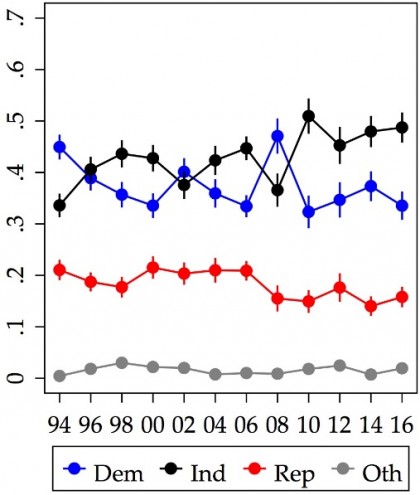Jill Rosen previews a Journal of Sociological Science report, which presents the results of a study of 30,000 eligible voters, exploring “how social class affected political identity in the run up to the 2016 presidential election.” According to Rosen’s article, “Shift away from party loyalty among working-class voters set stage for Trump’s victory” in Johns Hopkins University Magazine:
On the cusp of last year’s presidential election, many working-class voters who were once staunch Democrats had gone independent, opening the door for a non-traditional Republican candidate…”A substantial proportion of eligible voters within the working class turned away from solid identification with either the Democratic Party or the Republican Party during the Obama presidency,” wrote lead author Stephen L. Morgan, a Johns Hopkins Bloomberg Distinguished Professor of Sociology and Education. “Even before the 2016 election cycle commenced, conditions were uncharacteristically propitious for a Republican candidate who could appeal to prospective voters in the working class, especially those who had not voted in recent presidential elections but could be mobilized to vote.”
Morgan and graduate student Jiwon Lee studied data from the 1994 through 2016 editions of the General Social Survey, to model how party identification has evolved over the past 24 years…They focused on more than 30,000 eligible voters. The survey asks respondents which political party they identify with, as well as questions about their occupation and education, which allowed the researchers to determine how working-class voters aligned themselves politically over time.
“We found substantial change in party identification across the presidencies of Bill Clinton, George Bush and Barack Obama, particularly during Obama’s tenure,” Morgan said. “Many eligible working-class voters were becoming less attached to the Democratic Party, but their loyalties weren’t shifting to the Republican Party.”
Many of these voters—lower-paid, lower-skilled workers often in blue-collar jobs—had begun to consider themselves independent, Morgan found.

Image caption:A graphic of working-class party identification from 1994-2016 shows that most identify as independents.
The report likely won’t suprise political observers who have been studying white working-class party identification. But the large size of the study adds some weight to its conclusions. As for the reasons behind the trend, Rosen writes,
The survey didn’t explore why voters who changed party affiliation did so, but Morgan suspects a number of causes: a slow economic recovery after the recession, a failure by those in office to prosecute the individuals responsible for the collapse of financial institutions, and the continuing erosion of real wages for semi-skilled and unskilled workers…Rejection of the civil rights agenda, however defined, appears fashionable again..Morgan estimates that between 6 and 10 percent of working-class voters shifted allegiances, not enough for the Democratic Party to entirely lose its overall working-class advantage.
Whatever advantage Democrats still have with the working-class surely rests on the political preferences of African-American working-class voters, who remain the Dems’ most reliable supporters. Increasing Black voter turnout is still a critical chalenge for Democrats, regardless of white working-class voting trends.
Rosen notes “A silver lining for Democrats, Morgan said, is that some of these lost working-class voters didn’t support a traditional Republican, but someone who appealed to their economic interests.” Democratic candidates who figure out how to project themselves as serving working-class economic interests will find themselves in a good position to win in 2018.



